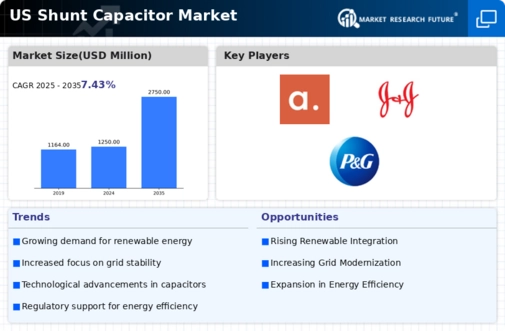Increasing Energy Demand
The shunt capacitor market is experiencing growth due to the rising energy demand across various sectors in the US. As industries expand and urbanization continues, the need for reliable and efficient power distribution systems becomes paramount. Shunt capacitors play a crucial role in enhancing power factor and reducing energy losses in electrical systems. According to recent data, the energy consumption in the US is projected to increase by approximately 10% over the next decade. This surge in demand necessitates the integration of shunt capacitors to ensure stable voltage levels and improve overall system efficiency. Consequently, the increasing energy demand is a significant driver for the shunt capacitor market, as utilities and industries seek to optimize their power systems and reduce operational costs.
Growth of Electric Vehicles
The shunt capacitor market is poised for growth due to the increasing adoption of electric vehicles (EVs) in the US. As the automotive industry shifts towards electrification, the demand for efficient charging infrastructure is rising. Shunt capacitors are essential components in EV charging stations, as they help manage reactive power and improve the overall efficiency of the charging process. The US government has set ambitious targets for EV adoption, aiming for 50% of new vehicle sales to be electric by 2030. This transition is expected to create a substantial demand for shunt capacitors, as utilities and charging station operators seek to enhance grid stability and support the growing EV market. Consequently, the growth of electric vehicles serves as a significant driver for the shunt capacitor market.
Rising Focus on Power Quality
The shunt capacitor market is significantly impacted by the increasing focus on power quality in the US. As industries and commercial establishments strive for operational efficiency, the need for high-quality power becomes essential. Power quality issues, such as voltage sags, harmonics, and flicker, can lead to equipment malfunctions and increased operational costs. Shunt capacitors are instrumental in mitigating these issues by improving power factor and stabilizing voltage levels. Recent studies indicate that poor power quality can result in losses of up to 5% in industrial settings. Therefore, the rising emphasis on maintaining power quality is likely to drive the demand for shunt capacitors, as businesses seek to enhance their operational reliability and reduce energy costs.
Emphasis on Renewable Energy Integration
The shunt capacitor market is benefiting from the increasing emphasis on renewable energy integration in the US. As the country transitions towards cleaner energy sources, the need for effective power management solutions becomes critical. Shunt capacitors are vital in balancing the intermittent nature of renewable energy sources, such as solar and wind. They help stabilize voltage levels and improve power factor, ensuring a reliable energy supply. The US has set ambitious renewable energy targets, aiming for 50% of electricity generation to come from renewable sources by 2030. This shift is likely to drive the demand for shunt capacitors, as utilities and energy producers seek to optimize their systems for renewable energy integration. Thus, the emphasis on renewable energy integration is a key driver for the growth of the shunt capacitor market.
Investment in Infrastructure Development
The shunt capacitor market is positively influenced by substantial investments in infrastructure development across the US. Government initiatives aimed at modernizing the electrical grid and enhancing energy efficiency are driving the demand for shunt capacitors. The US government has allocated billions of dollars for infrastructure projects, which include upgrading transmission and distribution networks. This investment is expected to create a favorable environment for the shunt capacitor market, as utilities and contractors seek to incorporate advanced technologies to improve grid reliability. Furthermore, The emphasis on smart grid technologies and renewable energy integration necessitates the use of shunt capacitors. These capacitors help manage reactive power and maintain voltage stability. As a result, infrastructure development serves as a critical driver for the growth of the shunt capacitor market.














Leave a Comment